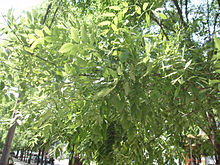Styphnolobium
| Styphnolobium | |
|---|---|

| |
| Styphnolobium japonicum foliage | |
| Scientific classification | |
| Kingdom: | Plantae |
| Clade: | Tracheophytes |
| Clade: | Angiosperms |
| Clade: | Eudicots |
| Clade: | Rosids |
| Order: | Fabales |
| Family: | Fabaceae |
| Subfamily: | Faboideae |
| Clade: | Cladrastis clade |
| Genus: | Styphnolobium Schott (1829) |
| Type species | |
| Styphnolobium japonicum (L.) Schott
| |
| Species[1] | |
|
9; see text | |
| Synonyms | |
| |
Styphnolobium is a
black locust. Necklacepod is a common name for plants in this genus.[5]
Etymology
From Greek styphno-, stryphno- "sour, astringent" and lobion "pod", because of the fresh pods' pulp taste.[6]
Species
Styphnolobium comprises the following species:[7][8][9]
Section Oresbios
- Styphnolobium affine (Torr. & A. Gray) Walp., the coralbean or Eve's necklace is native to the southern United States in Texas, Oklahoma, Arkansas and Louisiana. It is a large shrub or small tree, growing to 5–7 m tall, with white or pale violet flowers. The seeds of this species are believed to be poisonous.[10] The sapwood leaches a yellow dye on contact with water.[11]
- Styphnolobium burseroides M. Sousa & Rudd
- Styphnolobium caudatum M. Sousa & Rudd is native to Nicaragua.
- Styphnolobium conzattii (Standl.) M. Sousa & Rudd
- Styphnolobium monteviridis M. Sousa & Rudd is native to Central America.
- Styphnolobium parviflorum M. Sousa & Rudd
- Styphnolobium protantherum M. Sousa & Rudd
- Styphnolobium sporadicum M. Sousa & Rudd
Section Styphnolobium
- Styphnolobium japonicum (L.) Schott, the pagoda tree (Chinese Scholar, Japanese pagodatree; syn. Sophora japonica), is native to eastern Asia (mainly China; despite the name, it is introduced in Japan), is a popular ornamental tree in Europe, North America and South Africa, grown for its white flowers, borne in late summer after most other flowering trees have long finished flowering. It grows into a lofty tree 10–20 m tall with an equal spread, and produces a fine, dark brown timber.
Uses
The pagoda tree is widely used in
Ming Dynasty, Chongzhen
, hanged himself.
Styphnolobium japonicum (Chinese: 槐; pinyin: huái; formerly Sophora japonica) is one of the 50 fundamental herbs used in traditional Chinese medicine.
References
- ^ a b Styphnolobium Schott. Plants of the World Online. Retrieved 21 September 2023.
- .
- PMID 23221500.
- S2CID 86331839.
- ^ USDA, NRCS (n.d.). "Styphnolobium". The PLANTS Database (plants.usda.gov). Greensboro, North Carolina: National Plant Data Team. Retrieved 4 December 2015.
- ^ "Styphnolobium". Kew. Archived from the original on 2017-02-03. Retrieved 2017-01-23.
- ^ "ILDIS LegumeWeb entry for Styphnolobium". International Legume Database & Information Service. Cardiff School of Computer Science & Informatics. Retrieved 13 February 2014.
- USDA; ARS; National Genetic Resources Program. "GRIN species records of Styphnolobium". Germplasm Resources Information Network—(GRIN) [Online Database]. National Germplasm Resources Laboratory, Beltsville, Maryland. Archived from the originalon 24 September 2015. Retrieved 13 February 2014.
- JSTOR 2399827.
- ^ "Lady Bird Johnson Wildflower Center - the University of Texas at Austin".
- ^ "Dirt Doctor - Library Topics".
External links
![]() Media related to Styphnolobium japonicum at Wikimedia Commons
Media related to Styphnolobium japonicum at Wikimedia Commons
- Styphnolobium japonicum (as Sophora japonica)
- "Chinese Scholar Tree"
- The Evil God in the Pagoda Tree Japanese folktale with the Pagoda Tree at hyakumonogatari.com
